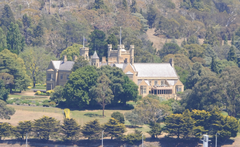Government House, Hobart
| Government House | |
|---|---|

Government House viewed from the River Derwent
|
|
| General information | |
| Architectural style | Gothic Revival |
| Town or city | Hobart, Tasmania |
| Country | Australia |
| Coordinates | 42°52′03″S 147°20′00″E / 42.867567°S 147.333415°E |
| Construction started | 1855 |
| Client | Governor of Tasmania |
| Technical details | |
| Size | 73 rooms on 15 hectares |
| Design and construction | |
| Architect | William Pordon Kay |
Government House, Hobart is the home and official residence of the Governor of Tasmania, Australia. The palatial house is located on Lower Domain Road in the Queens Domain, near the Royal Tasmanian Botanical Gardens, and is the official residence of the governor of Tasmania. There have been three Government Houses, all in Hobart.
In 1805, after two years in a tent at Sullivans Cove, Governor Collins moved into the first Government House – a new wooden hut in Barrack Square. As local bricks gradually became available the hut was extended, but it was a primitive three-room home that let in the wind and rain.
The second Government House was built in 1817 at the junction of Macquarie Street and what is now Elizabeth Street. It had 14 rooms on two storeys and had servants' quarters, a coach house and stables, but it was badly built – of brick, wood and stucco, with later extension of sandstone – and was demolished in 1858.
Tasmania's Government House is today regarded as one of the best Vice Regal residences in the Commonwealth. Designed by the Director of Public Works and colonial architect William Porden Kay, it is a fine example of an early Victorian country house in Gothic Revival style and is one of the largest of its type in Australia.
Work eventually started in 1855 on a hill of the 37-acre (150,000 m2) grounds that overlooks the Royal Tasmanian Botanical Gardens and the Derwent estuary. Sandstone was quarried on site (the excavated holes were made into ornamental pools), cedar and teak were recycled from an old ship, and slate for the roof was imported from Wales. Furniture was imported from London. Construction was completed in 1857
...
Wikipedia
